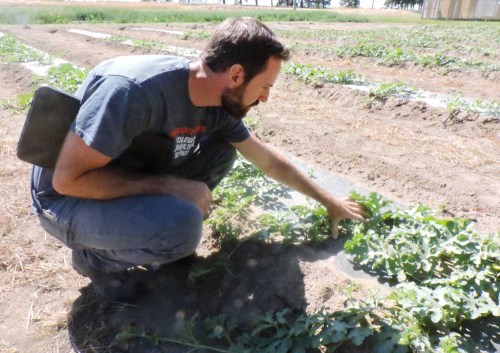Oregon farm program cuts less severe than expected
Published 12:30 pm Friday, August 14, 2020

- Scott Lukas, assistant professor of horticulture at Oregon State University, checks on his watermelon trials June 28, 2017, at the Hermiston Agricultural Research and Experiment Station.
SALEM — Lawmakers have cut funding for Oregon State University’s agricultural experiment station, Extension service and forest research lab, though not as drastically as originally proposed.
These three components of OSU’s “statewides” funding were slashed by $3.6 million during the Oregon Legislature’s second special session, which took place on Monday, Aug. 10.
Trending
Specifically, funding was reduced by $1.9 million for the agricultural experiment station, which conducts research at 11 branches; by $1.4 million for the Extension service, whose agents advise farmers, ranchers and communities throughout Oregon; and by nearly $300,000 for the forest research laboratory, which studies management, ecosystems and materials.
Before the special session convened, however, the Joint Committee on Ways and Means, which makes budget decisions, recommended decreasing OSU statewides funding by about $7.2 million. That figure amounted to a 10% annual budget cut.
The Oregon Farm Bureau, Oregon Cattlemen’s Association, Oregon Association of Nurseries, Oregon Dairy Farmers Association and other natural resource groups urged lawmakers against reducing funding for OSU statewides, arguing these programs serve a critical function during the coronavirus pandemic.
Oregon’s tax revenues are expected to be about $2 billion lower than previously forecast during the current budget biennium, a decline of roughly 10 percent, due to the economic disruption from the coronavirus outbreak.
Aside from avoiding a deeper funding reduction for OSU statewides, lawmakers also decided against cuts proposed for rural fire protection associations, county fairs and FFA, said Mary Anne Cooper, vice president of public policy for the Oregon Farm Bureau.
“There’s a lot for us to be grateful here,” she said. “The cuts aren’t as bad as they were originally proposed to be.”
Trending
The Farm Bureau was also concerned about a proposed cut of roughly $320,000 to the Oregon Department of Fish and Wildlife’s wolf program, fearing the funding loss would further undermine assistance to ranchers.
While lawmakers did end up cutting that $320,000 from the general fund, they directed about $200,000 worth of federal dollars toward the wolf program, resulting in a net decrease of about $120,000.
The agency saved money with the delayed hiring of three staff members, which should be enough to keep the wolf program “relatively whole.” However, questions remain about funding during the next budget cycle, Cooper said.
Likewise, lawmakers may be hard pressed to make future “proactive investments” in water infrastructure, sage grouse programs and repairing coastal tide gates that protect farmland, she said.
“It’s really hard to see how they’re going to be able to fund that as we look toward the 2021-2023 biennium,” Cooper said.
Though some programs defended by farm groups were spared during the legislative session, other funding was slashed despite their arguments.
For example, $400,000 in additional predator control funding previously allocated to the Oregon Department of Agriculture and Department of Fish and Wildlife was now eliminated by lawmakers.
The Oregon Invasive Species Council’s funding was reduced by $280,000 and the Oregon Water Resources Department’s cost sharing and field services programs were cut by about $3.6 million.
“We always knew there was going to be some impact to agriculture programs and that ended up being true,” Cooper said.









